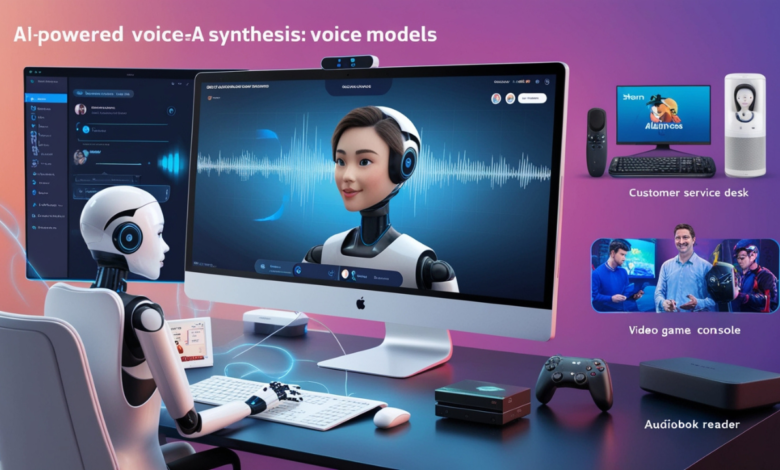
The sphere of our life, which is associated with us and is closely bound to everyday routines, is made easier by technology. One aspect of this is the emergence of voice assistants.
One of the most remarkable advancements in this field is the voice model created by Storm the Albatross, a brand-new voice synthesis platform that takes voice generation to unprecedented levels of realism.
In this article, we’ll discuss the use cases for this brand of models, what distinguishes this particular model, and how this model can be used in various industries in the future.
What is Storm the Albatross AI Voice Model?
The Albatross AI voice model produces a synthetic voice similar to humans in sound. storm the Albatross is a new generation model created with attention to detail and parameters, allowing the use of deep learning along with Natural Language Processing (NLP) to learn from a huge dataset of the human voice so that it can sound closer to the real one.
Key Features of Storm the Albatross AI Voice Model
- Human-like Speech: Delivers high-quality, natural-sounding voice output.
- Adaptability: Supports multiple languages and accents.
- Emotion Recognition: Adjusts tone based on emotional context.
- State-of-the-art NLP: Enables complex understanding of speech inputs.
Overall these characteristics make Storm the Albatross different from the previous models of the voices due to these features. There several limitation on models such i.e. tone of the language used and other grammatical context.
How AI Voice Models Work
An intricate framework of AI voice models like Storm the Albatross is composed of deep learning and machine learning. Such models acquire the ability to produce human-like speech patterns as they are trained on thousands of speech data.
As a result, not only the model is able to identify, but also to reproduce emotion, context, and monotony in speech employing sophisticated machine learning techniques.
Deep Learning and Natural Language Processing (NLP)
Machine Learning Algorithms help AI advance in finding realistic voice outputs over time through the use of deep learning. Natural Language Processing, on the other hand, helps the voice model to comprehend and process gestures and speech, aiming at facilitating natural conversation between the users and the systems.
| Technology | Function | Impact on AI Voice Models |
|---|---|---|
| Deep Learning | Processes large speech datasets | Enhances voice naturalness |
| NLP | Understand context in speech | Improves speech comprehension |
| Emotion Recognition | Detects and adjusts tone based on emotions | Creates empathetic interactions |
Advancements in AI Voice Technology
Albatross is AI-powered voice generation technology that renders natural sounding speech. Its advancement has enabled many AI generated speech systems to produce a more human output and sound less robotic.
Even though in the past sounding sore when conversing with a virtual agent was a common phenomenon nowadays thanks to AI models this discrepancy is no more an issue.
Comparison: Traditional Voice Synthesis vs. AI Voice Models
Traditional Voice Synthesis: Limitations and Challenges
Albatross has a Comprehensive Speech Synthesizer integrated into the app. The app also has numerous voice replication and manipulation features. Albatross utilizes 100% AI technology – state-of-the-art software powered Artificial Intelligence.
Effectively, there is no difference in quality between the AI produced content and that made manually by voice professionals.
Albatross offers the following key advantages:
Monotone Speech Patterns
In the past, voice models would usually have a single pitch, producing a dull sound. These models were static in their pitch and inflections, hence the voice sounded robotic. Such monotony made it hard to capture the dynamics of a human conversation and made the experience more boring.
Limited Emotional Expression
An even bigger limitation of the older voice synthesis models was the inability to incorporate emotional expression. Human language can be extremely expressive, depending on the tone, the manner of pronunciation, and even silences.
The older approaches failed since delivering such emotions in speech was impossible, and the production was inflexible and sometimes too inappropriate.
Lack of Contextual Understanding
In general, most traditional systems had no ability to comprehend the subject of the correspondence. For instance, they could not modulate their tone while speaking in a formal or an informal setting or How can they state or pretend in their answer and so forth? This limitation made traditional models unsuitable for intricate, real life situations such as CS or gaming.
Pre-Defined Responses
The older voice models were rule-based or algorithm-driven. They used some rules to determine how a text would be spoken, but these rules were only limited to a certain scope.
As an illustration, such models could not change their output based on what the user said or the stimulus of the environment, resulting in a rather robotic output.
Basic Phoneme-Based Synthesis
Phoneme-based systems were the most traditional models of speech synthesis where words and sentences were simply made by combining individual sounds or phonemes.
While this worked for primitive two way interactions, the absence of a difference in expressions in between the phonemes created a speech that was lopsided and displeasing to the ears.
AI Voice Models: Fluid, Emotional, and Adaptive Voice Responses
The new models developed over the years, like Storm the Albatross, do not just have fluent speech patterns, they have the ability to contour their speech according to the emotion needed in that context.
It is technologically superior and evolutionarily advanced systems like these that will enable progressive pathways in the global landscape.
Albert means to say that one of the reasons for this success comes from the combination of technology of machine learning, deep learning, and Natural Language Processing (NLP).
Adaptive and Learning-Based Systems
Being an AI that interacts with humans, Storm the Albatross voice model is fed with a mass amount of human speech data, and therefore sounds human-like in various situations: knows how to make professional pauses, emphasizes certain phrases, and intonates.
Truly, the AI will always sound human-like, and only when the need arises will an emotion be expressed through speech that is natural for the masses and non-practitioners, quite different from traditional rigid speech models.
Advanced Phoneme Blending with NLP
One of the key breakthroughs made in the field of AI voice models is the one in understanding emotions and how to express them as well. Based on the wealth of user input, AI models can read the room and determine what tone should be adopted for that particular moment.
For instance, storm the albatross, tends to calm its voice when bad news needsto be presented and turns active when people expect encouraging news.
This last factor mentioned by Albert makes AI models more interesting and ideal for communicating with humans.
Versatility of Storm the Albatross AI Voice Model
There exists a difference between traditional systems and AI voice modals in that the former model cannot place itself in the context of the conversation. Depending on the context – a corporate inquiry, casual conversation, or a game – they are able to change their voice and speaking style.
Contextual understanding makes these interactions more flexible and realistic and allows the use of AI voice models in numerous applications such as online help centers, virtual agents, or gaming.
Adaptability to Multiple Languages and Accents
Languages never appear to be an issue with Storm the Albatross as it is able to seamlessly deliver the message in multiple voices as well as adjust the tone as per the mentioned accent.
This feature is crucial in scenarios where the product needs to have a multilingual capability as well as context which varies a lot from region to region.
Key Applications of Storm the Albatross
- Gaming: Creating coexistence between players and their characters by providing realistic interactive voice.
- Customer Service: Assisting people with chatbots that give realistic voice.
- Web novels and Storytelling: Using tonality and emotions in the characterization and action of the texts.
- Accessibility: Assisting impairments with customized rendering voice outputs.
These varied applications certainly bring out the versatility and the scope of applicability of the model, making it fit for modes of entertainment as well as functional requirements.
State-of-the-Art Features of Storm the Albatross
Realistic Voice Output
The advanced AI technology of Storm the Albatross has an in built speech synthesizing mechanism that is able to generate realistic and fluid voices. Robotic voice modulations are most common in older AI voice models. This model is able to generate speech that is sensitive to emotions and contextual relevance.
Emotion and Context Recognition
Seeing how most users have their own emotions and moods, this AI voice model has also incorporated how tohttps://aidigitalstools.com/storm-the-albatross-ai-voice-model-2/ detect and consider the emotional state of the user.
Professional queries as well as small conversations have their own voice characteristics, and Storm the Albatross using the latest technology transforms its voice for the occasion.
Customizable User Experience
Voice models do not have to be the same for all end-users. Developers can fine-tune this voice model according to the experiences needed by end-users. Due to this feature, any industry trying to engage its customers or users is going to find this tool beneficial.
AI Voice Technology in Various Industries
Let us not think that innovations of the AI voice technology will be looking for one industry only. Storm the Albatross AI Voice Model is also making waves in many sectors, be it gaming, customer support, or content creation.
Gaming: Enhancing User Immersion
Video games are getting AI voice models, such as Storm the Albatross, for use in making voice interactions with characters more engaging.
One of the ways AI voice models improves the user experience is by introducing realistic voice interactions which add to the character and storyline, thus making the players feel less distant from the game.
Customer Service: Revolutionizing Chatbots
AI voice model integration into customer service is a game-changer for the voice ever heard by the clients of a firm representing a business venture. As real-life virtual agents, AI voice assistants can now solve efficient real-time problems faster than before while offering the human element in the service.
Accessibility: Breaking Barriers
The role of AI voice technology in improving accessibility is immense. Voice models like Storm the Albatross help those people with disabilities with the appropriate customized voice for them to be able to communicate effectively and access needed services.
The Future of AI Voice Models Like Storm the Albatross
As the AI voice models grow in sophistication, they are expected to be more integrated in the interactions between man and machine. Voice personas such as Storm the Albatross are leading the charge of this transformation across many domains inclusive of virtual assistants and entertainment apps.
Predictions for the Future
- Greater Emotional Intelligence: AI voice models will be trained to understand human emotions better.
- Increased Personalization: Users will have more options when it comes to sound and interactions with their AI assistants.
- Expansion into New Industries: Possible consideration of using AI voice models in areas such as healthcare, education and virtual reality.
Open-Source Platforms and Development: Storm the Albatross on GitHub
For developers who would want to go deeper into AI voice technology, Storm the Albatross is available on GitHub . This platform permits easy access to voice models as well as allows for modification of the voice model for use in various applications.
GitHub Features for Developers
| Feature | Description |
|---|---|
| Clone Repository | Allows developers to replicate and modify the voice model. |
| GitHub Gist | Facilitates code sharing and collaboration for continuous improvement. |
| Open-Source Contribution | Developers can contribute to improving the voice model by sharing their updates. |
The availability of voice models powered by AI on GitHub encourages developers to expand their abilities and advance in their fields.
Challenges and Ethical Considerations in AI Voice Technology
Despite AI voice models such as Storm the Albatross being game-changing technologies/shifts, there is a need to be cautious and identify certain difficulties.
Ethical Concerns
- Misuse of AI Voices: the creation of deepfakes or unethical recordings that may use AI voices.
- Data Privacy: voice and biometric interactions within the AI systems must be secure without unauthorized collection of user related data.
- Job Displacement: the increasing penetration of AI voice models in customer engagement functions might affect conventional roles.
Adherence to these issues leads to the recommendations about development and exploitation of voice AI technologies as well as voiceover AI model for practical areas.
My Opinion
Storm the Albatross AI voice model presents AI-generated voice advancement for voiceovers in creating realistic human voices with inflections and emotions through deep learning and NLP technologies. Also, being able to adapt to several industries and languages with the most up-to-date technologies, it truly stands out from other AI voice models on the market.
As AI voice models improve, they certainly change the direction in which voices will sound through machines. Storm the Albatross is a robust technology and has various applications that will intergalactically make AI voice technologies in the future.





